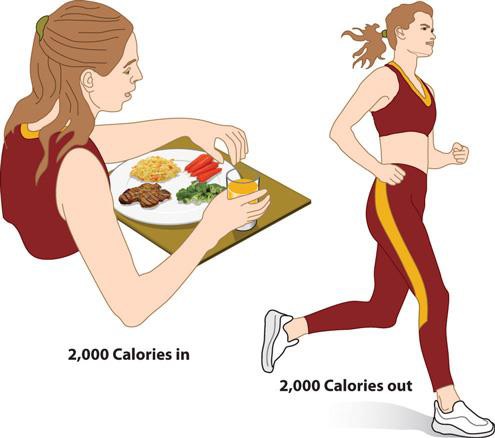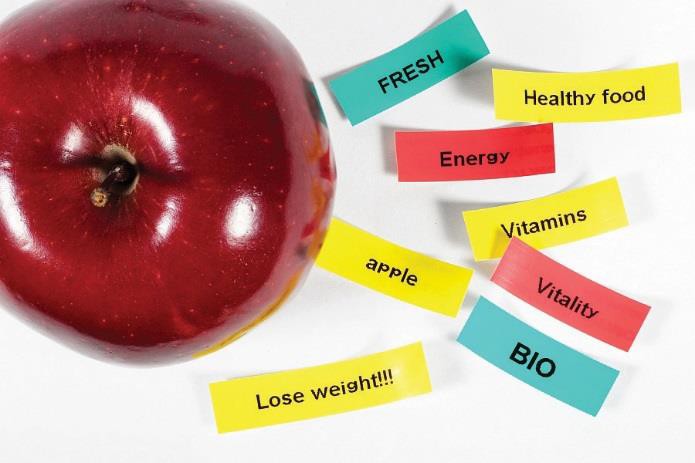Chapter 2: Achieving a Healthy Diet
2.2 Principles of a Healthy Diet
Achieving a healthy diet is a matter of balancing the quality and quantity of food that is eaten. There are five key factors that make up a healthful diet:
- A diet must be adequate, by providing sufficient amounts of each essential nutrient, as well as fiber and calories.
- A balanced diet results when you do not consume one nutrient at the expense of another, but rather get appropriate amounts of all nutrients.
- Calorie control is necessary so that the amount of energy you get from the nutrients you consume equals the amount of energy you expend during your day’s activities.
- Moderation means not eating to the extremes, neither too much nor too little.
- Variety refers to consuming different foods from within each of the food groups on a regular basis.
A healthy diet is one that favors whole foods. As an alternative to modern processed foods, a healthy diet focuses on “real” fresh whole foods that have been sustaining people throughout the millenniums. Whole foods supply the needed vitamins, minerals, protein, carbohydrates, fats, and fiber that are essential to good health. Commercially prepared and fast foods are often lacking nutrients and often contain inordinate amounts of sugar, salt, saturated and trans fats, all of which are associated with the development of diseases such as atherosclerosis, heart disease, stroke, cancer, obesity, high cholesterol, diabetes, and other illnesses. A balanced diet is a mix of food from the different food groups (vegetables, legumes, fruits, grains, protein foods, and dairy).
ADEQUACY
An adequate diet is a diet that provides all of the nutrients your body needs, including vitamins, minerals, healthy fats, fiber, and calories. Nutrient-dense foods are an important part of an adequate diet. These foods contain many essential nutrients per calorie, and so they can help you get an adequate amount of essential nutrients without going over the amount of calories you need. Nutrient-dense foods are the opposite of “empty-calorie” foods. If your diet has a lot of empty-calorie foods in it, you may go well above your calorie budget and still not have an adequate diet. Nutrient-dense foods include fruits and vegetables, lean meats, poultry, fish, low-fat dairy products, and whole grains. Choosing more nutrient-dense foods will facilitate maintenance of a healthy weight, while simultaneously providing all necessary nutrients.
Table 2.21 The Smart Choice: Nutrient-Dense Food Alternatives[1]
|
Instead of… |
Replace with… |
|
Sweetened fruit yogurt |
Plain fat-free yogurt with fresh fruit |
|
Whole milk |
Low-fat or fat-free milk |
|
Cheese |
Low-fat or reduced-fat cheese |
|
Bacon or sausage |
Canadian bacon or lean ham |
|
Sweetened cereals |
Minimally sweetened cereals with fresh fruit |
|
Apple or berry pie |
Fresh apple or berries |
|
Deep-fried French fries |
Oven-baked French fries or sweet potato baked fries |
|
Fried vegetables |
Steamed or roasted vegetables |
|
Sugary sweetened soft drinks |
Seltzer mixed with 100 percent fruit juice |
|
Recipes that call for sugar |
Experiment with reducing amount of sugar and adding spices (cinnamon, nutmeg, etc…) |

BALANCE
Balance the foods in your diet. Achieving balance in your diet entails not consuming one nutrient at the expense of another. For example, calcium is essential for healthy teeth and bones, but too much calcium will interfere with iron absorption. Most foods that are good sources of iron are poor sources of calcium, so in order to get the necessary amounts of calcium and iron from your diet, a proper balance between food choices is critical. Another example is that while sodium is a vital nutrient, an overabundance of it can contribute to congestive heart failure and chronic kidney disease. Remember, everything must be consumed in the proper amounts.
MODERATION
Eat in moderation. Moderation is crucial for optimal health and survival. Burgers, French fries, cake, and ice cream each night for dinner will lead to health complications. But as part of an otherwise healthful diet and consumed only on a weekly basis, this should not have too much of an impact on overall health. If this is done once per month, it will have even less of an impact upon overall health. It is important to remember that eating is, in part, about enjoyment and indulging with a spirit of moderation. This fits within a healthy diet.
CALORIE CONTROL
Monitor food portions. For optimum weight maintenance, it is important to ensure that energy consumed from foods meets the energy expenditures required for body functions and activity. If not, the excess energy contributes to gradual, steady weight gain. In order to lose weight, you need to ensure that more calories are burned than consumed. Likewise, in order to gain weight, calories must be eaten in excess of what is expended daily.

VARIETY

Variety involves eating different foods from all the food groups. Eating a varied diet helps to ensure that you receive all the nutrients necessary for a healthy diet. One of the major drawbacks of a monotonous diet is the risk of consuming too much of some nutrients and not enough of others. Trying new foods can also be a source of pleasure—you never know what foods you might like until you try them.
Developing a healthful diet can be rewarding, but be mindful that all of the principles presented must be followed to derive maximal health benefits. For instance, introducing variety in your diet can still result in the consumption of too many high-calorie, nutrient-poor foods and inadequate nutrient intake if you do not also employ moderation and calorie control. Using all of these principles together will afford you lasting health benefits.
Table 2.22 Food Choices for a Healthful Diet[2]
| Grain | Whole-grain products: brown rice, quinoa, barley, buckwheat, millet, wild rice, oats, rye berries, sorghum, bulgur, kasha, farrow, wheat berries, corn, amaranth, spelt |
| Vegetable | Dark green: broccoli, collards, kale, romaine lettuce, spinach, turnip greens, watercress |
| Red and orange: Acorn squash, butternut squash, carrots, pumpkin, red peppers, sweet potatoes | |
| Beans and peas: Black beans, black-eyed peas, chickpeas, kidney beans, lentils, navy beans, pinto beans, soybeans, split peas, white beans | |
| Starchy: Cassava, green bananas, green peas, green lima beans, plantains, potatoes, taro, water chestnuts | |
| Other vegetables: Asparagus, avocado, bean sprouts, beets, Brussels sprouts, cabbage, cauliflower, celery, eggplant, green beans, green peppers, mushrooms, okra, onions, parsnips | |
| Fruit | apples, apricots, bananas |
| Berries: strawberries, blueberries, raspberries, cherries, grapefruit, kiwi fruit, lemons, limes, mangoes | |
| Melons: cantaloupe, honey dew, watermelon | |
| Other fruits: nectarines, oranges, peaches, pears, papaya, pineapple, plums, prunes | |
| Dairy | all fluid milk (fat free, low-fat, reduced-fat, whole milk, lactose-free), fortified soy milk, yogurt |
| Hard natural cheeses: cheddar, mozzarella, Swiss, parmesan |
|
| Soft cheeses: ricotta, cottage cheese |
|
| Protein | Meats: beef, ham, lamb, pork, veal |
| Poultry: chicken, goose, turkey, duck |
|
| Eggs | |
| Beans and peas: (see vegetable section) |
|
| Nuts and seeds: almonds, cashews, hazelnuts, peanuts, pecans, pistachios, pumpkin seeds, sesame seeds, sunflower seeds, walnuts |
|
| Seafood: catfish, cod, flounder, haddock, halibut, herring, mackerel, pollock, porgy, salmon, sea bass, snapper, swordfish, trout, tuna | |
| Shellfish: scallops, mussels, crab, lobster |
- Source: US Department of Agriculture. “Food Groups.” http://www.choosemyplate.gov/food-groups/. ↵
- Source: Adapted from https://www.myplate.gov/eat-healthy/protein-foods. ↵
A Calorie is a unit of food energy. 1 kilocalorie = 1 Calorie = 1000 calories
Vitamins are organic compounds that must be taken in from the diet.
Minerals are solid inorganic substances that form crystals and are classified depending on how much of them we need. Trace minerals such as zinc, iron, or iodine are only required in a few milligrams or less per day. Major minerals such as calcium, sodium, and potassium are required in hundreds of milligrams per day.
Carbohydrates are a macronutrient composed of carbon, hydrogen, and oxygen in a 1:2:1 ratio and are soluble in water.
Atherosclerosis is a condition that occurs when too much plaque builds up in your arteries, causing them to narrow.
“heart disease” refers to several types of heart conditions. The most common type is coronary artery disease, which can cause a heart attack. Other kinds of heart disease may involve the valves in the heart, or the heart may not pump well and cause heart failure.
Lean foods contain fewer than a set amount of grams of fat for that particular cut of meat.

